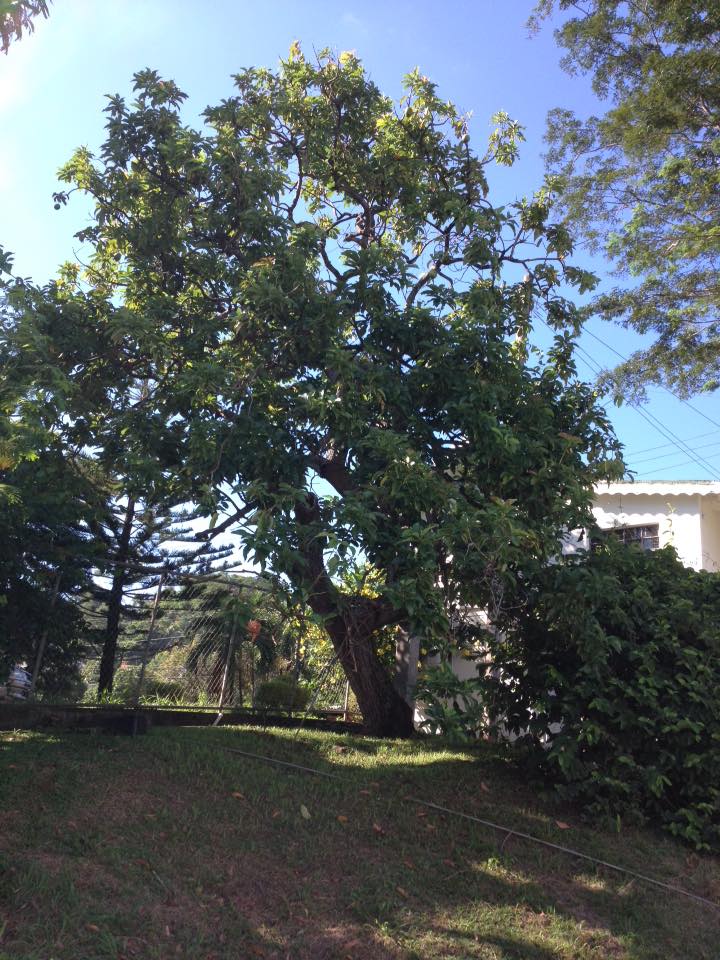Persia americana



Plant Family: Belongs to the Lauraceae family of usually aromatic trees and shrubs; only member of family with edible fruit of any importance; other Lauraceae include Cinnamon (Cinnamomum verum), the American Bay Leaf or Bay Laurel (Laurus nobilis), and Laurier Blanc (Ocotea dominicana) of the Dominica’s montane forests.
Description: A delicious fruit, popular throughout the world; tree evergreen, medium sized, up to 18 m (60 ft), but more often about 9 m (30 ft); trunk 30-60 cm diameter (12 to 24 in), often short with spreading branches beginning close to ground; leaves alternate, dark-green, glossy on the upper surface, whitish on the underside, variable in shape from lanceolate to elliptical, oval to obovate, 7.5-40 cm long (3 to 16 in); flowers small, pale-green or yellow-green, borne profusely in racemes near branch tips; an unusual feature of flowers is that they open as female on one day, close, then open as male the following day; fruit pear-shaped, oval, or nearly round, may be 7.5-33 cm long (3-13 in) and up to 15 cm wide (6 in); skin color variable, yellow-green, deep-green or very dark-green, reddish-purple to dark purple; skin texture smooth or pebbled, glossy or dull, thin or leathery, pliable or granular and brittle; edible flesh pale to rich-yellow, green on outside, buttery and bland or nutlike in flavor, with 3-35% oil depending on variety; single seed round, conical or ovoid, 5-6.4 cm long (2-2.5 in), hard, ivory colored and enclosed in a two-ply, brown, thin, papery seedcoat; some fruits seedless. Prior to hurricane David in 1979, there was perhaps half an acre of various avocado cultivars at the southern end of the Gardens, including Pollock with the largest fruit, and thick, firm, buttery flesh. Few trees remain today.
Races and Varieties: three races - West Indian, Mexican and Guatemalan:
West Indian (P. americana var. americana): skin leathery, pliable, non-granular; flesh low in oil, leaves non-aromatic; grown primarily in West Indies and tropics of Old World; one cultivar of superior flavor is Pollock; very large (up to 5 lb), with smooth, shiny skin, flesh 3-5% oil; two other popular vars are Rushle and Russell.
Guatemalan (P. nubigena var. guatemalensis): arose in subtropical highlands of tropical America; skin varies from thin to very thick, granular or gritty, oil content very high, up to 34%; among the prominent cultivars are MacArthur and Edranol.
Mexican (P. americana var. drymifolia): most cold resistant and hardiest of Avocado races; thrives in subtropics and will tolerate some winter freeze; skin thin and tender, clings to the flesh; flesh very high in oil; leaves have pronounced anise-like odor; prominent cultivars include, Puebla and Zutano. There are also numerous hybrids of these three races.
Natural Habitat: Thrives on a wide range of soils from red clay to sandy to limestone soils; however, individual races require more specific climatic conditions – West Indian race needs tropical and subtropical climates with high humidity; Guatemalan race is somewhat hardier, thriving even in the cooler subtropics; Mexican race is the hardiest, is not suited to tropical climates, and temperatures as low as 25ºF (-4ºC) do it little harm; is source of most California avocados; avocado propagation is by seed and grafting; fresh seeds germinate in 4 to 6 weeks; seedlings begin bearing as early as 4 years, and continue bearing for 50 years or more; however, offspring unlikely to resemble parent cultivar in fruit quality; therefore, commercial orchards are planted using grafted trees and rootstocks, allowing perpetuation of cultivars and early fruiting.
Origin and Distribution: Thought to have originated in southern Mexico; was cultivated from the Rio Grande to central Peru long before arrival of Europeans; now distributed to almost all of tropical and subtropical world with suitable environmental conditions; is grown commercially in many countries, including Cuba, Mexico, southern France, South Africa and the United States (Florida and California).



